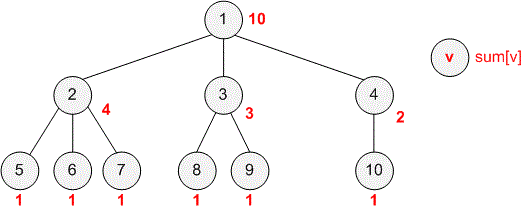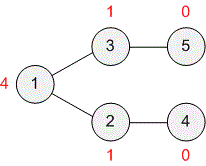Розбір
The structure of the company is a tree. For each vertex in the tree, determine the number of vertices in the subtree where is the root. The number of subordinates for employee will be (since employee is not his own subordinate).
Initiate a depth-first search starting from vertex , which corresponds to the general director of the company. If are the children of vertex , then
If vertex is a leaf in the tree, set .

Example
Consider the example. Next to each employee (vertex of the graph), the number of their subordinates is indicated.

Algorithm realization
The tree is stored in the adjacency list .
vector<vector<int> > g;
The dfs function performs a depth-first search from vertex and returns the number of vertices in the subtree rooted at . Vertex is the parent of in the depth-first search.
int dfs(int v, int p)
{Initially, the subtree rooted at contains only the vertex .
sum[v] = 1;
Consider the edge . If , add to the number of vertices in the subtree rooted at .
for (int to : g[v])
if (to != p) sum[v] += dfs(to, v);Return the number of vertices in the subtree rooted at .
return sum[v]; }
The main part of the program. Read the input data. Construct a tree.
scanf("%d", &n);
g.resize(n + 1);
for (i = 2; i <= n; i++)
{
scanf("%d", &x);For employee , its immediate supervisor in the company is .
g[i].push_back(x); g[x].push_back(i); }
Start the depth-first search from vertex .
sum.resize(n + 1); dfs(1, -1);
Print the answer. The number of subordinates of employee is equal to .
for (i = 1; i <= n; i++)
printf("%d ", sum[i] - 1);
printf("\n");Java realization
import java.util.*;
public class Main
{
static ArrayList<Integer>[] g;
static int sum[];
static int n;
static int dfs(int v, int p)
{
sum[v] = 1;
for(int to : g[v])
if (to != p) sum[v] += dfs(to,v);
return sum[v];
}
@SuppressWarnings("unchecked")
public static void main(String[] args)
{
Scanner con = new Scanner(System.in);
n = con.nextInt();
g = new ArrayList[n+1]; // unchecked
sum = new int[n+1];
for (int i = 0; i <= n; i++)
g[i] = new ArrayList<Integer>();
for (int i = 2; i <= n; i++)
{
int x = con.nextInt();
g[i].add(x);
g[x].add(i);
}
dfs(1,-1);
for (int i = 1; i <= n; i++)
System.out.print(sum[i] - 1 + " ");
System.out.println();
con.close();
}
} Python realization
Increase the stack for recursion.
import sys sys.setrecursionlimit(1000000)
The dfs function performs a depth-first search from vertex and returns the number of vertices in the subtree rooted at . Vertex is the parent of in the depth-first search.
def dfs(v, p):
Initially, the subtree rooted at contains only the vertex .
sum[v] = 1
Consider the edge . If , add to the number of vertices in the subtree rooted at .
for to in g[v]:
if to != p: sum[v] += dfs(to,v)Return the number of vertices in the subtree rooted at .
return sum[v]
The main part of the program. Read the number of employees.
n = int(input())
Initialize the adjacency list of the graph .
g = [[] for _ in range(n+1)]
Read the input data. Construct a tree.
lst = list(map(int, input().split())) for i in range(2,n+1): a = lst[i-2]
For employee , its immediate supervisor in the company is .
g[a].append(i) g[i].append(a)
Initialize the list .
sum = [0] * (n + 1)
Start the depth-first search from vertex .
dfs(1,-1)
Print the answer. The number of subordinates of employee is equal to .
for i in range(1, n+1): print(sum[i] - 1,end=" ")